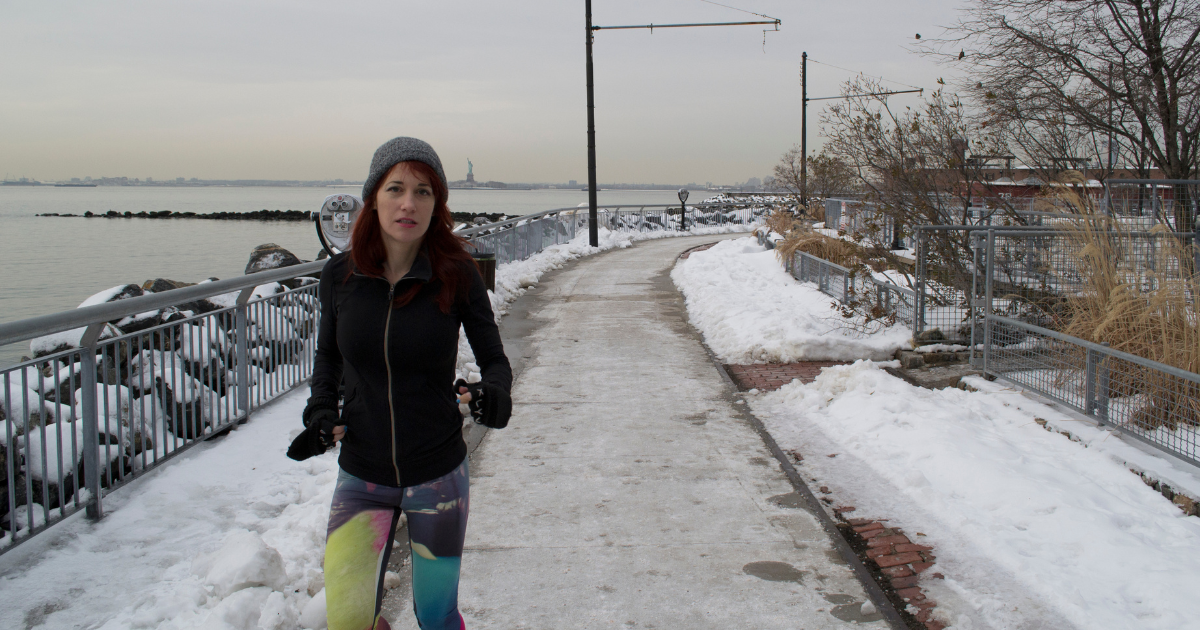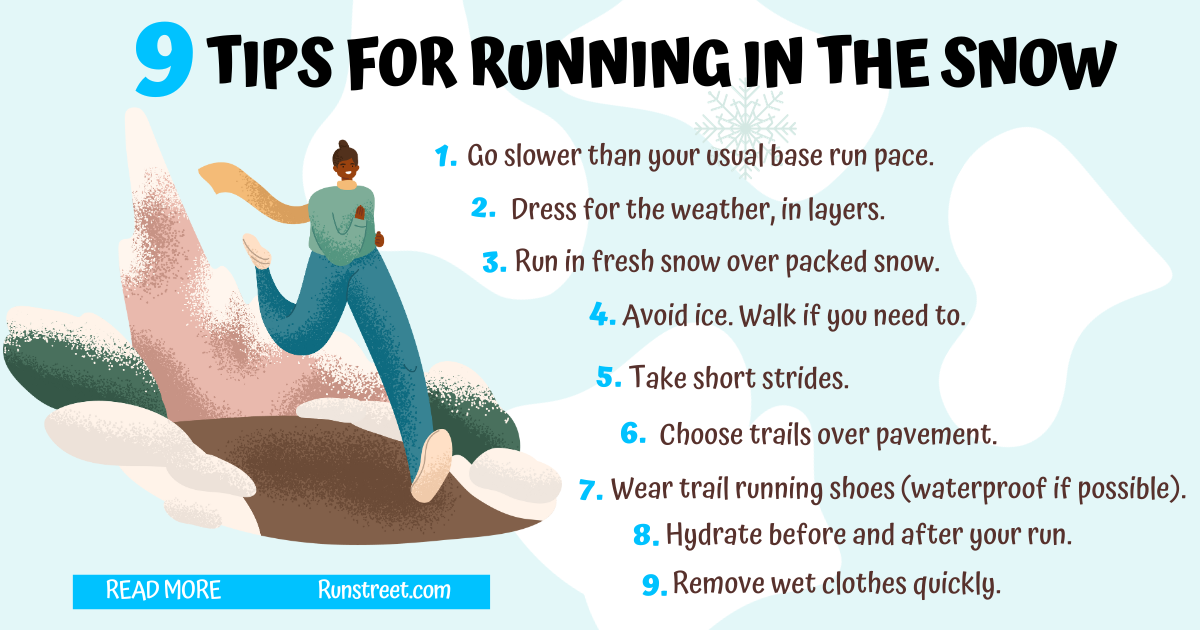Snow Running Tips from a Run Coach
Snow running in Brooklyn. Photo by Marques Jackson Photography.
By Marnie Kunz, NASM-certified trainer, USATF-, RRCA-certified running coach
If you hate the treadmill and live in an area that gets cold in the winter, snow running may become an issue for you. The good news is, running in the snow is definitely possible with the right gear and tactics. Plus snow running can be so beautiful and peaceful, much more exciting than a treadmill jaunt. Whether you have just one snowfall a year or many, these snow running tips will help you stay safe and happy for many snowy miles to come.
Disclaimer: When you buy through our links, we may earn a commission - at no extra expense to you. We are an Amazon Associate. We only link products we have tried or come highly recommended. Learn more.
It’s easy to get overwhelmed by the feeling of wet feet or worry about slipping in the snow, but with the right methods, you can have a great run in the snow and even enjoy the wintery wonderland around you. I admit I avoided running in the snow a lot until covid came and gyms were closed. Then a particularly snowy, cold winter hit, and I found myself traipsing through the snow with my enthusiastic snow dog. And I found, through trial and error, a lot of ways to make snow running more fun and manageable. Here are my tips as a run coach and a snow runner convert.
How to Run in Snow
Running in the snow is similar to running in the sand in that it is more difficult and your pace will be slower than your usual base run speed. So throw any time expectations out the window. You'll need to protect your feet with either waterproof trail running shoes or running shoes with snow cleats like Yak Trax for better grip and traction when running in the snow.
Also, as with trail running, you are using more muscles and expending more energy to run in the snow than you would for a regular road run. So you may run a shorter distance than usual but you will still get in a great workout for your major lower body and core muscle groups.
The snow presents unique challenges as your feet can become wet and cold or you can slip on frozen water or mud. Snow running is completely different than running on dry pavement. For running in the snow, you want to follow some safety tips to minimize your risk of slips and reduce your risk of injury.
Related: Best Winter Running Gear to Stay Warm and Safe
Safety Tips for Snow Running
Check the weather first to make sure you can run outside. If it is icy outside or too cold to run, do an indoor workout. Generally, if it’s below 0 degrees Fahrenheit or negative 18 Celsius, I would not recommend running outside. Also, if there is black ice or the trails by you are all icy, opt for an indoor workout. If there’s regular snow, then you can run outside. The main thing is to avoid ice and extreme cold.
Choose fresh snow over packed snow. New snow offers better traction so you’re less likely to slip than if you run on older, packed-down snow that often turns icy.
Layer up. Wear plenty of protection against the cold, including moisture-wicking layers, with a running jacket, base layer, gloves, hat or headband, and thick running socks made of merino wool or other warm materials. Check out our winter running tips for more cold weather clothing advice.
Run on trails instead of pavement when possible. Pavement is more likely to get packed down and slippery or icy whereas trails offer more traction for snow running. If you don’t have trails, you can run in open fields of snow or on a track, which are less slick than roads and sidewalks, making it easier to stay upright.
Prepare your running shoes for the snow. I got trail running shoes with a waterproof outsole made of Gore-Tex to run in the snow and they were a game-changer for keeping my feet dry and comfortable. If you can swing for some waterproof trail shoes, this will help you a lot in your snow running. Trail shoes also have extra traction to help grip the ground and prevent slipping. You can also get cleats to clip on your shoes for running in the snow. Yaktrax Run Traction Cleats fit over your running shoes and offer extra lugs with good grip so you can run in snowy conditions.
Shorten your stride. Adjust your running technique for the snow. Taking smaller steps gives you more control and balance so you are less likely to slide and fall and your body can adjust to the uneven terrain of snow running. Also, watch for patches of ice which can be under the snow or on the ground in wet areas. Taking smaller steps can allow you to more easily go around icy sections of trail.
Walk in icy areas. If you come across icy areas during your run, slow down to walk. This will give you more stability and decrease your risk of slipping.
Adjust your workout. Do not try to run fast or do a speed workout in the snow as you risk slipping and also your pace will naturally be slower due to the extra friction of snow running. Running in deep snow is especially challenging and will give you a full-body workout. You will not need to go as far as usual for your runs as you’ll expend more energy than normal when running in the snow. Snow running is similar to running in sand, and takes a lot of energy. Adjust your mileage accordingly.
Hydrate. You’ll be working harder than usual when you’re running in the snow so make sure you drink plenty of water after your run to rehydrate.
Change wet clothes quickly. Once you finish your snow running adventure, it’s important to change out of your wet clothes as soon as possible. Sitting around in wet clothes, especially if you’re n cold temperatures, places extra stress on your immune system while also being very uncomfortable.
Running in the snow can be challenging but beautiful.
Snow Running Gear
My best investment for snow running gear so far is my Nike Pegasus Trail GORE-TEX running shoes. These are waterproof versions of the regular Nike Pegasus Trail shoes and they are so helpful for keeping my feet dry in snow and are also perfect for rainy day runs. Trail running shoes also have more traction on the bottom than regular running shoes so they make it easier to grip the snow and uneven terrain.
Another option that llows you to keep on your regular running shoes is to add Yaktrax Run Traction Cleats to your shoes for better traction when running on snowy, rough terrain.
For snow running gear, wear moisture-wicking running clothes, starting with a base layer. For an insulating base layer in extreme cold, try a thick long-sleeved running shirt with a moisture-wicking material. Finish off your layers with a warm, moisture-wicking running jacket. If you have a budget for it, you can spring for a waterproof running jacket with Gore-Tex material. If not, your regular winter running jacket will be fine, you just may get wet eventually if it is still snowing as you run.
Also, don’t forget to cover your head with a beanie for warmth and wear running gloves to keep your hands warm. Your head loses a lot of heat so it’s important to keep it covered, especially in windy and cold conditions. For running gloves, opt for some that are compatible with touch screens so you can access your phone easily if needed for running safety.
Happy Trails to You!
Now that you’re prepared for the snow, enjoy your runs in winter wonderland! The peaceful beauty of snow days will not last forever so enjoy your snow running as much as you can. Follow and tag me in your winter running posts to get cheered on - I’m @Runstreet on Instagram. And sign up for our free newsletter to get more training tips, deals, and coaching advice delivered to your inbox. Stay safe and happy trails to you!😊
Related Posts: Dog Grumbles and My First Run Streak, Running Essentials: The Base Run, 10 Winter Running Tips, Running Safety Tips
Marnie Kunz is a NASM-certified trainer and USATF- and RRCA-certified running coach based in Brooklyn, NY. Marnie likes helping people get and stay active to enjoy a better quality of life. When she’s not doing fitness things, Marnie enjoys exploring with her dog, a mischievous rescue Akita.




